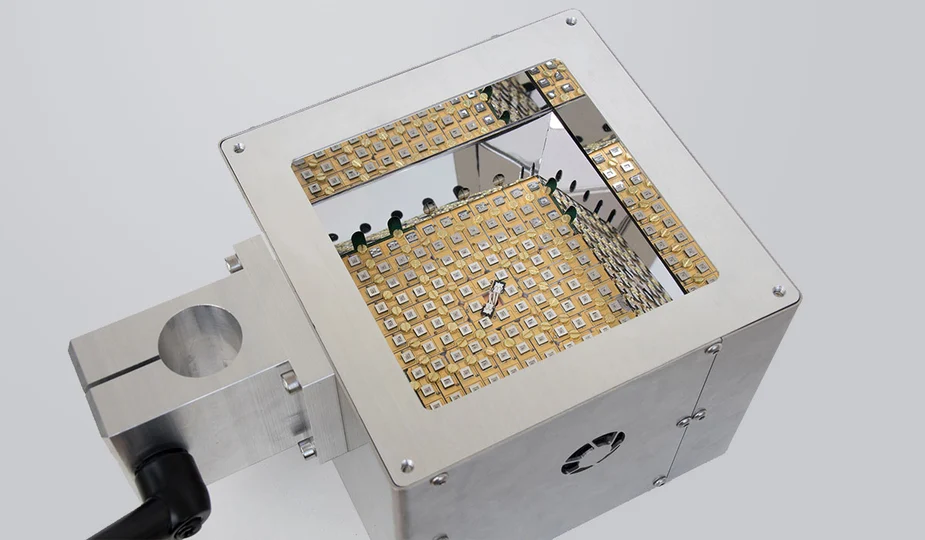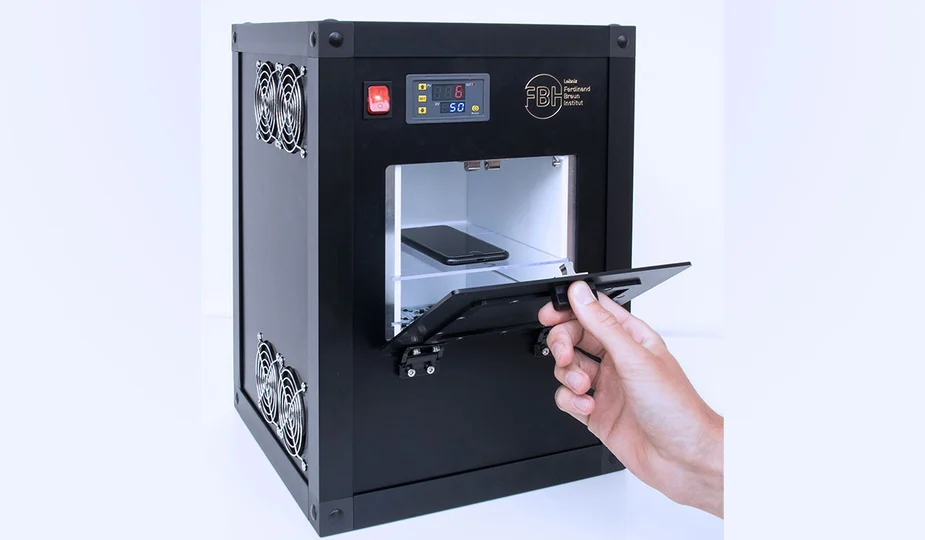UVC light-emitting diodes to fight coronaviruses
FBH, UVphotonics, TU Berlin and Osram Opto Semiconductors develop suitable irradiation systems
In the joint CORSA project, SARS-CoV-2 and further respiratory viruses on surfaces and skin are to be inactivated by using UVC light. The project team is developing special UVC LEDs for this purpose and is investigating parameters such as wavelengths, irra-diation doses and virus habitats. The German Federal Ministry of Education and Re-search is supporting the three-year project from 2021 with a total of three million euros.
Like bacteria and fungi, viruses can be inactivated by UVC light. However, for the current coronavirus SARS-CoV-2, no reliable data on the optimal wavelengths and irradiation doses have been available to date. This is to change with the CORSA project (Inactivation of SARS-CoV-2 by UVC light and tolerability for humans), which has now been launched. The competencies of the nine project partners* cover the complete value chain up to commercial use. The partners are further developing UV light-emitting diode (LED) technologies and performing comprehensive tests to ensure that the irradiation is as effective as it is safe for humans.
UVC LEDs in the wavelength range around 270 nm provide the basis for irradiating non-living surfaces, especially in air filters. LEDs with emissions around 233 nm are to be used directly on humans. In order to test the effectiveness of UVC radiation in aerosols and on human and animal skin, the Ferdinand-Braun-Institut (FBH) is developing suitable LEDs and irradiation systems in cooperation with the Technische Universität Berlin (TU Berlin), UVphotonics NT GmbH and Osram Opto Semiconductors GmbH.
In the long term, UVC LEDs, filters and ventilation technology, among others, are to be combined in a way that will reduce restrictions on economic and social life in the event of pandemics, especially in enclosed spaces. UVC LEDs offer many advantages: They are small, can be precisely adjusted to the optimum wavelength and are non-toxic, unlike conventional mercury vapor lamps.
270 nm UVC LEDs – to eliminate viruses on non-living surfaces and in aerosols
270 nm LEDs, which Osram Opto Semiconductors is currently working on, will be used for non-living surfaces that are not suited for chemical disinfection, as well as for aerosols. In particular, the project partners are testing how to eliminate the coronavirus in ventilation systems when the circulated air or filters are irradiated. In the process, the optimal irradiation doses and times that effectively inactivate the virus will be determined. The project thus also provides fundamental insights into how UVC radiation can be used to effectively fight SARS-CoV-2 and other respiratory viruses such as influenza viruses. The Institute for Animal Hygiene and Environmental Health at Freie Universität Berlin is testing the effect on coronaviruses in aerosols, and TU Berlin is testing disinfection in air handling systems.
233 nm UVC LEDs – eliminating viruses directly on humans or in their immediate vicinity
UVC LEDs with emission wavelengths around 233 nm cause little damage to human skin. This makes them attractive for antisepsis as well as for disinfection of busy indoor areas, for example in schools, theaters or operating rooms. Such LEDs are currently not commercially available.
However, FBH and TU Berlin have been researching and developing UVC LEDs for several years as part of their Joint Lab GaN Optoelectronics and are worldwide leading in light emitting diodes in this wavelength range. Building on their expertise in semiconductor technologies, they are collaborating with UVphotonics to further increase the output power, conversion efficiency and lifetime of the LEDs.
Unlike longer-wavelength UVC radiation – from mercury vapor lamps, for example – the light emitted by these LEDs penetrates only a few micrometers into the skin and thus barely reaches the deeper, living cells. It is therefore expected that the skin can compensate for possible minor damage with its natural repair mechanisms. To ensure that the technology is safe for humans, the Department of Dermatology at Charité – Universitätsmedizin Berlin is conducting in vivo tests to determine the effect of UVC radiation on skin. Data on the virucidal effect are coming from the Friedrich-Loeffler-Institut and the Universitätsmedizin Greifswald.
Using existing know-how
Charité and Universitätsmedizin Greifswald can rely on their experience from the VIMRE project. Since mid-2020, they have been testing 233 nm wavelength irradiation systems developed by FBH to inactivate multidrug-resistant pathogens in hospitals, such as MRSA, on the body surface. The technology basis of the UV LEDs was created as part of the "Advanced UV for Life" consortium and jointly developed by TU Berlin and FBH.
FBH also has extensive experience in prototyping UV LED irradiation systems, designed and constructed according to specific requirements. Only recently, an irradiation system with 265 nm UV LEDs was completed in cooperation with the FBH spin-off UVphotonics. 128 of these LEDs disinfect everyday objects such as mobile phones or masks on a UV-transparent pane from above and below. In less than ten minutes, the system reaches a UV dose of 500 mJ/cm2, as recommended, for example, by the Centers for Disease Control and Prevention (US Department of Health & Human Services).
*Project partners
- Universitätsmedizin Greifswald
- Friedrich-Loeffler-Institut
- Charité –Universitätsmedizin Berlin
- Technische Universität Berlin
- Ferdinand-Braun-Institut, Leibniz-Institut für Höchstfrequenztechnik
- Freie Universität Berlin
- Osram Opto Semiconductors GmbH
- UVphotonics NT GmbH
- Mann+Hummel GmbH
About the FBH
The Ferdinand-Braun-Institut, Leibniz-Institut fuer Hoechstfrequenztechnik (FBH) researches electronic and optical components, modules and systems based on compound semiconductors. These devices are key enablers that address the needs of today’s society in fields like communications, energy, health, and mobility. Specifically, FBH develops light sources from the visible to the ultra-violet spectral range: high-power diode lasers with excellent beam quality, UV light sources and hybrid laser systems. Applications range from medical technology, high-precision metrology, and sensors to optical communications in space and integrated quantum technology. In the field of microwaves, FBH develops high-efficiency multi-functional power amplifiers, and millimeter wave frontends targeting energy-efficient mobile communications as well as car safety systems. The FBH has a strong international reputation and ensures rapid transfer of technology by working closely with partners in industry and research. The institute has a staff of 340 employees and a budget of 40.4 million euros. It is a member of the Leibniz Association and part of »Research Fab Microelectronics Germany«.
Contact:
Petra Immerz, M.A.
Communications Manager
Ferdinand-Braun-Institut, Leibniz-Institut für Höchstfrequenztechnik
Gustav-Kirchhoff-Straße 4, 12489 Berlin
Phone +49 30 6392-2626
Email petra.immerz(at)fbh-berlin.de
www.fbh-berlin.de
Press release 12/17/2020 Ferdinand-Braun-Institut, Leibniz-Institut für Höchstfrequenztechnik

